This tutorial shows you how to check the Application User Model ID (AUMID, also known as AppID or AppUserModelID) of installed apps in Windows 11/10. Each installed app has a unique Application User Model ID and is independent of its display name, installation directory, or path. Windows uses AUMID (or AppID) values to identify applications and differentiate them for launching, telemetry, switching, and other functions. AUMID of apps is also needed to configure assigned access to create a dedicated or kiosk device. So, this step-by-step tutorial is surely helpful for those looking to find the Application User Model ID of installed apps. You won’t need any third-party tool to get the AppID of installed apps.
How to check Application User Model ID (AppID) of installed apps in Windows 11/10
We have covered four native Windows 11/10 options to check the Application User Model ID (AUMID or AppID) of installed apps. These are:
- Check the Application User Model ID of installed apps using File Explorer
- Find Application User Model IDs of installed apps using Windows PowerShell
- Find an application’s AUMID or AppID using Registry Editor
- Get AppIDs or AUMIDs of installed apps using Command Prompt.
Let’s check these options.
1] Check the Application User Model ID of installed apps using File Explorer
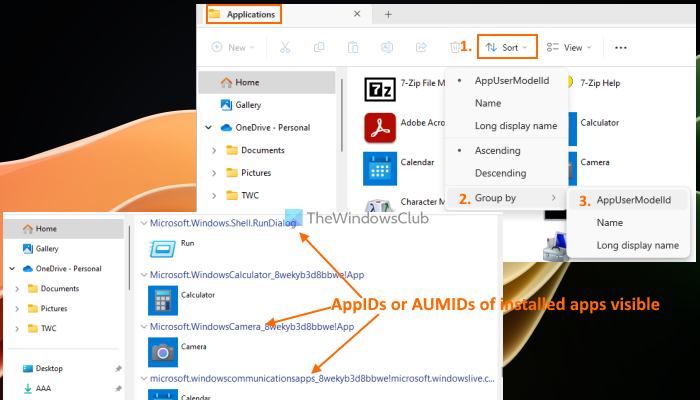
This is an easier way to find the Application User Model IDs of applications installed on your Windows 11/10 PC. The steps are:
- Open the Run Command box using Win+R hotkey
- Type
shell:Appsfolderin the text field - Press the Enter key. It will open the Applications folder tab in File Explorer where you will see a list of installed programs and apps
- Now click on the Sort menu > Group by > AppUserModelID
- The applications are grouped immediately and you will see the AppID of each installed application separately along with the application name and its icon/logo
- Later, when you have noted down or get the Application User Model ID of all apps, you can again change the Group by mode of installed apps by Name, Long display name, or None.
There is another way to find the AUMIDs of installed apps using File Explorer.
Once you have opened the Applications folder in File Explorer, right-click on an empty area > Group by > and select More… option. It will open a Choose Details box. In that box, select the AppUserModelID option, and press OK.
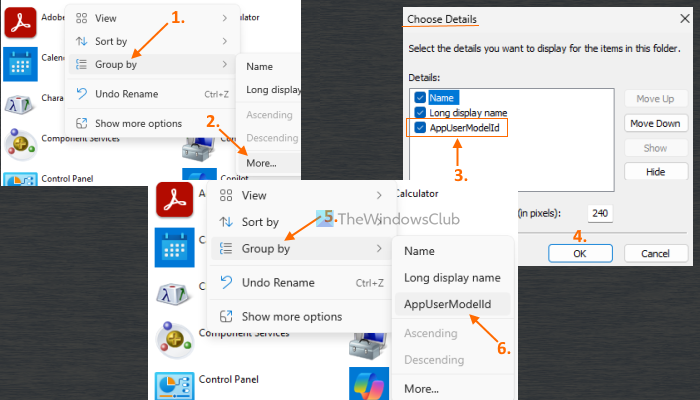
Now, again right-click on an empty area and access the Group by section. This time you will see the AppUserModelID option there. Select it. AppIDs will group the apps. Once your work is done, you can switch back the Group by mode to None.
2] Find Application User Model IDs of installed apps using Windows PowerShell
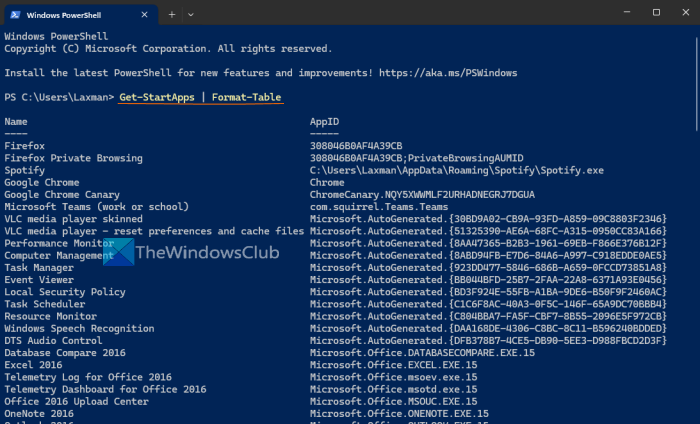
Using the Windows PowerShell option, you can get the Application User Model IDs of all installed applications available in the Start menu. Apps not listed in the Start menu won’t appear in the result.
Open Windows Terminal, and launch the PowerShell profile in a tab. Or else, you can directly open Windows PowerShell using the Search box or another preferred way. After opening PowerShell, run the following command:
Get-StartApps | Format-Table
Here Get-StartApps cmdlet generates a list of all installed apps available in the Start menu along with their AppIDs and Format-Table cmdlet formats the output as a table.
Alternatively, you can also use the following script to get the output. Just copy the script given below and paste it in Windows PowerShell. You might have to press the Enter key twice to generate the result.
$installedapps = Get-AppxPackage
$aumidList = @()
foreach ($app in $installedapps)
{
foreach ($id in (Get-AppxPackageManifest $app).package.applications.application.id)
{
$aumidList += $app.packagefamilyname + "!" + $id
}
}
$aumidList
The above script doesn’t provide the names of installed apps. Only a list of AUMID is generated for the installed apps. You can easily find out which AUMID is associated with which app because the AUMID or AppID also includes the name of the associated app.
Read: How to find the Installation date for apps and programs on Windows PC
3] Find an application’s AUMID or AppID using Registry Editor
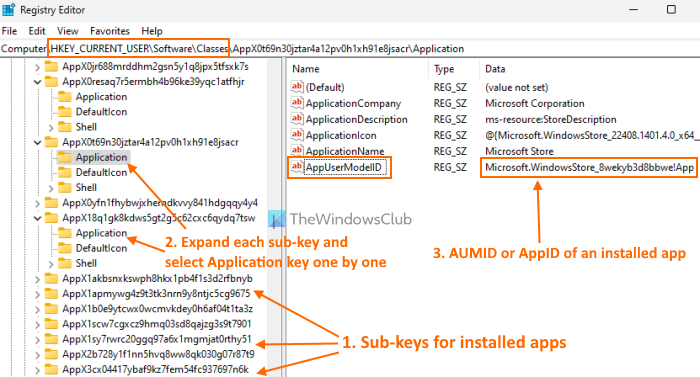
This is a lengthy option but you will surely find the AUMID or AppID of each installed application using Registry Editor for the current user. The steps are as follows:
- Open the Registry Editor window on your Windows 11/10 PC
- Navigate to the Classes Registry key. The path is:
HKEY_CURRENT_USER\Software\Classes
- Expand the Classes Registry key. You will see plenty of sub-keys. Scroll down and look for sub-keys with long names like AppX0t69n30jztar4a12pv0h1xh91e8jsacr, AppX0resaq7r5ermbh4b96ke39yqc1atfhjr, etc. These sub-keys are associated with the installed apps. Now this option is complicated because the Registry keys don’t include app names. So, you need to check them one by one manually
- Expand such sub-keys one by one. Each sub-key contains an Application named Registry key (as visible in the image above). Select the Application Registry key and you will see Name (AppUserModelID) and its data which is the AppID or AUMID of that particular app.
There’s an easier way to get the benefit of this method which is covered in the next solution. Let’s check it out.
4] Get AppIDs or AUMIDs of installed apps using Command Prompt
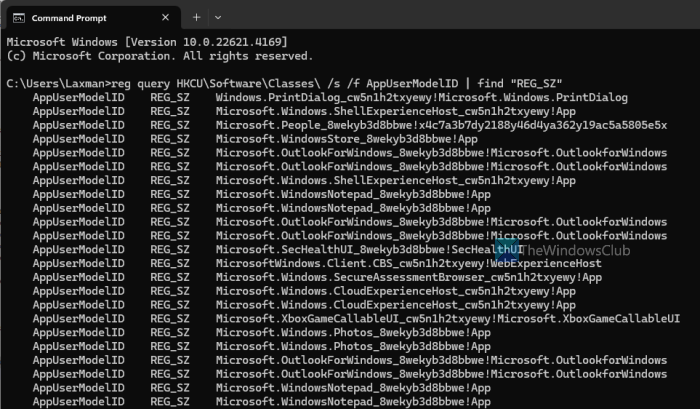
This option takes the help of Windows Registry to get the Application User Model ID of each installed application for the current user. It fetches the data of installed apps from the HKEY_CURRENT_USER root key of Windows Registry where AppID or AppUserModelID for each app is present. Finding such data directly from the Windows Registry is complicated and time-consuming. But this option makes it easier and get the work done in seconds.
To get the AppIDs or AUMIDs of installed apps for the current user using the Command, open the Command Prompt window and execute this command:
reg query HKCU\Software\Classes\ /s /f AppUserModelID | find "REG_SZ"
A list of AppUserModelIDs will be in front of you.
Read: Where are Microsoft Store Apps installed and how to access the folder
How do I find the GUID of an application in Windows?
A GUID (Globally Unique Identifier) is a 128-bit value and it includes a group of 8 hexadecimal digits, 3 groups of 4 hexadecimal digits, and a group of 12 hexadecimal digits. It looks like 7D29FB40-AV72-1067-D91D-00AA030663RA. If you want to find the GUID of MSI packages installed on your PC, then the easier way is by using elevated Windows PowerShell. Enter the following command and you will get a list of IdentifyingNumber along with Name and LocalPackage (MSI path):
get-wmiobject Win32_Product | Sort-Object -Property Name |Format-Table IdentifyingNumber, Name, LocalPackage –AutoSize
You can also use the Windows Registry to find GUID on a Windows PC.
How do I find the application ID in Windows?
If you want to find the application process ID in Windows 11/10, open the Task Manager. Access the Processes tab. Right-click on the Name, Status, or any other column, and select the PID option. This will add a PID column that will show a unique process ID for each running application and process on your Windows system. You can also use Registry Editor, PowerShell, or the Resource Monitor tool to find the process ID of applications.
Read next: How to open multiple instances of Microsoft Store apps on Windows PC.
Leave a Reply